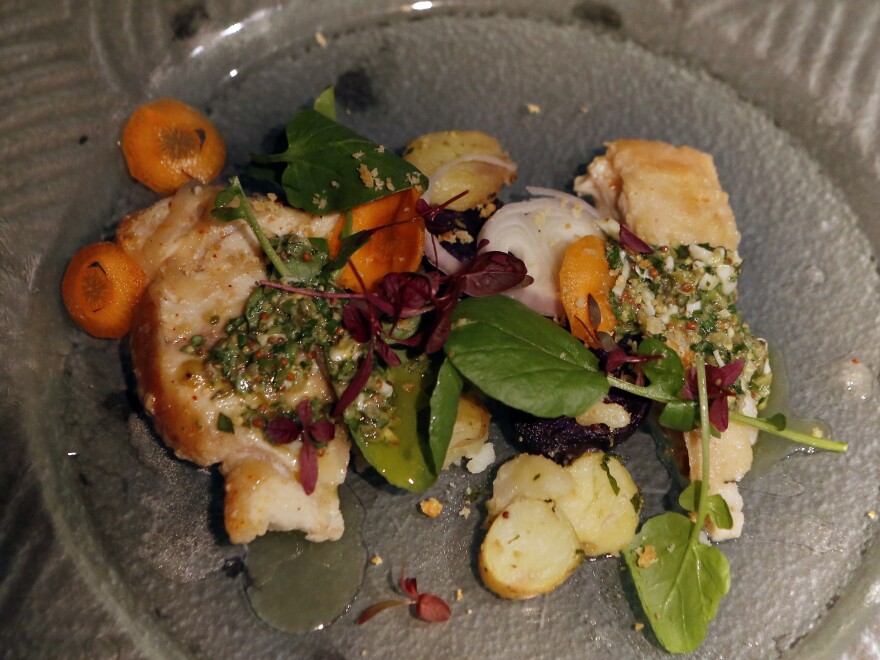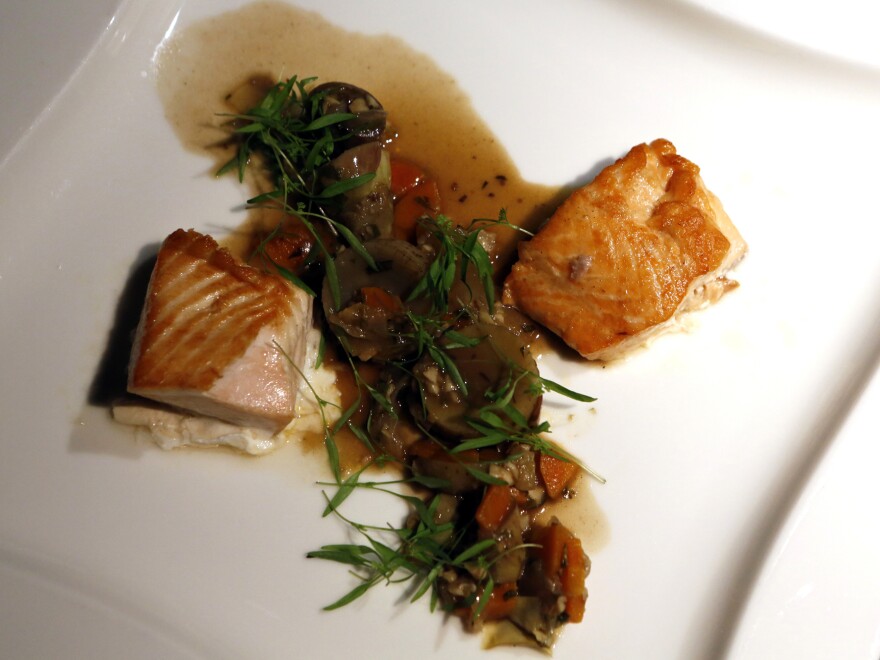In the world of seafood, looks can be very deceiving. And unfortunately for anyone who buys fish, it's easy for people above you in the supply chain to sell you something other than what you want.
Oceana, a conservation group, has been beating the drum about seafood mislabeling for a while. Back in February, the organization released a study that found that 33 percent of the seafood it sampled at retail outlets in 21 states was mislabeled. (Note: The sampling was not randomized, so the findings should be taken with a grain of salt.)
This month, Oceana hosted a dinner with the National Aquarium in Washington, D.C., to prove once again how easy it is to become a victim of seafood fraud.
"It's nearly impossible for anyone – even experts — to tell the difference between many species of fish," Beth Lowell, Oceana's campaign director, tells The Salt.

The event began with a raw fish guessing game. Kimberly Warner, Oceana's senior scientist, stood with a clipboard and pen by a large silver bowl filled with ice and six glistening fillets of fish. The objective? To correctly identify wild salmon, red snapper and halibut paired with almost doppelgangers beside them.
Many of the guests were flummoxed by the task. Listen to how some made up their minds:

The undecided included chef Xavier Deshayes of the Ronald Reagan Building and International Trade Center, who had prepared the meal we would soon eat. At first, Deschayes told me that he doesn't fall victim to mislabeling because he uses only purveyors that he trusts.
But as soon as he saw the two coral-colored fillets of salmon on the ice, he admitted that he didn't know which one was wild. "It's a lot easier to tell when you're looking at a whole fish instead of a fillet," he said.
Steve Vilnit, director of fisheries marketing for the Maryland Department of Natural Resources, said he struggled with the snapper. "The sinew in the meat ... I'm thinking, but I don't know; that's a tough one."
After most guests had tried their hand at identifying the raw fillets, we sat down to a meal of some of the most commonly mislabeled fish species: grouper, salmon and red snapper. Each course featured two equally sized pieces of fish prepared in exactly the same way.

The first was grouper, cooked escabeche-style, and paired with potato salad. Its lookalike, Oceana's Lowell eventually told us, was a virtually indistinguishable piece of weakfish. In the February report, the group had found that 11 of the 44 samples of grouper, or 25 percent, were mislabeled.
Next up was the salmon course, with farm-raised salmon pitted against its wild counterpart. Listen to some of the guests' reactions:
Dehayes told me that farm-raised salmon has thicker layers of fat, and that the additional fat gives it a moister, more buttery texture. "I prefer farmed salmon to wild salmon, because wild salmon gets so dry when you cook it," he said. That turned out to be a helpful tip when it came time to taste the fish. The fish on the right felt apart in my mouth so easily, while the fish on the left, while delicious, was firmer and had a stronger, fishier taste. It was the wild salmon.

Lastly, we tasted red snapper, alongside a typical imposter: tilapia. Red snapper is the most commonly mislabeled fish, according to the Oceana report: Only seven of the 120 samples the group purchased and sampled were actually red snapper.
The prevalence of mislabeled red snapper gives consumers a distorted view of its availability, says Lowell. Another downside is that fishermen who are trying manage red snapper fisheries sustainably, like the ones in the program who manage the catch in the Gulf of Mexico, have to compete against double-dealers who may have different priorities.

The snapper that Dehayes had prepared was covered in a chimichurri crust and served with fresh corn polenta. Although the snapper and tilapia had slightly different textures, strong spices made it tough to tell the two apart. It was easy to see why diners are so often tricked.
So who's to blame for all this mislabeling? According to Oceana, it's really hard to tell. It could be happening in the boat, during processing, at the wholesale level, at the retail counter or somewhere else along the way. But as Deshayes notes, if you're eating fraudulent fish at a restaurant, it may not be the fault of the chef.
Many chefs, especially those running large operations, buy fish that's already been filleted to save time. So that makes it harder for even the sharpest-eyed among them to spot imposters in the kitchen.
To stop mislabeling, Oceana would like to see an international traceability system to inform consumers where and when a fish was caught and what gear was used. But political support for such a system, which would be costly, has been tepid.
The seafood industry — one of the least transparent in the food system — has a long way to go before it can become more accountable to consumers. So in the meantime, ask chefs about which retail outlets they trust, and sharpen those senses.
Copyright 2021 NPR. To see more, visit https://www.npr.org. 9(MDAxNzg0MDExMDEyMTYyMjc1MDE3NGVmMw004))







